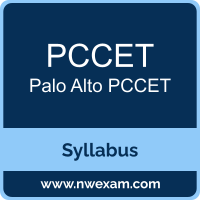 A great way to start the Palo Alto Networks Certified Cybersecurity Entry-level Technician (PCCET) preparation is to begin by properly appreciating the role that syllabus and study guide play in the Palo Alto PCCET certification exam. This study guide is an instrument to get you on the same page with Palo Alto and understand the nature of the Palo Alto PCCET exam.
A great way to start the Palo Alto Networks Certified Cybersecurity Entry-level Technician (PCCET) preparation is to begin by properly appreciating the role that syllabus and study guide play in the Palo Alto PCCET certification exam. This study guide is an instrument to get you on the same page with Palo Alto and understand the nature of the Palo Alto PCCET exam.
Our team of experts has composed this Palo Alto PCCET exam preparation guide to provide the overview about Palo Alto Cybersecurity Entry-level Technician exam, study material, sample questions, practice exam and ways to interpret the exam objectives to help you assess your readiness for the Palo Alto PCCET exam by identifying prerequisite areas of knowledge. We recommend you to refer the simulation questions and practice test listed in this guide to determine what type of questions will be asked and the level of difficulty that could be tested in the Palo Alto PCCET certification exam.
Palo Alto PCCET Exam Overview:
|
Exam Name
|
Cybersecurity Entry-level Technician |
| Exam Number | PCCET |
| Exam Price | $110 USD |
| Duration | 90 minutes |
| Number of Questions | 90-100 |
| Passing Score | 860/300 to 1000 |
| Exam Registration | PEARSON VUE |
| Sample Questions | Palo Alto PCCET Sample Questions |
| Practice Exam | Palo Alto Networks Certified Cybersecurity Entry-level Technician Practice Test |
Palo Alto PCCET Exam Topics:
| Section | Weight | Objectives |
|---|---|---|
| Fundamentals of Cybersecurity | 30% |
- Distinguish between Web 2.0 and 3.0 applications and services - Describe port-scanning methodologies and their impact
- Recognize applications used to circumvent port-based firewalls
- Describe the business processes of supply-chain management
- Describe the impact of governance, regulation, and compliance
- Describe the tactics of the MITRE ATT&CK framework
- Identify the different attacker profiles and motivations
- Describe the different phases and events of the cyberattack lifecycle
- Identify the characteristics, capabilities, and appropriate actions for different types of malware and ransomware
- Identify what chain of events follows an attack
- Differentiate the TCP/IP roles in DDoS attacks
- Describe advanced persistent threats
- Describe perimeter-based network security
- Describe the Demilitarized Zone (DMZ)
- Describe Zero Trust
- Describe the integration of services for network, endpoint, and cloud
|
| Network Security Components | 30% |
- Differentiate between hubs, switches, and routers
- Describe the use of VLANs
- Identify the borders of collision and broadcast domains
- Describe the advantages of SD-WAN
- Differentiate between categories of IoT devices
- Identify IoT connectivity technologies
- Describe the purpose of a default gateway
- Describe the data-encapsulation process
- Identify the characteristics of various types of network firewalls
- Describe the application of NGFW deployment options (i.e., PA-, VM- and CN-Series)
- Describe virtual private networks
- Differentiate between the different tunneling protocols
- Differentiate the various types of security functions from those that are integrated into UTM devices
- Identify differences in managing wireless devices compared to other endpoint devices
- Describe the integration of NGFWs with the cloud, networks, and endpoints
- Describe network security management
|
| Cloud Technologies | 20% |
- Describe the NIST cloud service and deployment models - Recognize and list cloud security challenges
- Identify the 4 Cs of cloud native security
- Explain the purpose of containers in application deployment
- Describe how serverless computing is used
- Describe the cost of maintaining a physical data center
- Describe the network-as-a-service layer |
| Elements of Security Operations | 20% |
- Describe the main elements included in the development of SOC business objectives - Describe the components of SOC business management and operations - List the six essential elements of effective security operations - Describe the four SecOps functions
- Describe SIEM |
Palo Alto PCCET Exam Description:
The Palo Alto Networks Certified Cybersecurity Entry-Level Technician (PCCET) certification is designed to validate knowledge, understanding, and the basic skills required to apply solutions in the areas of cybersecurity, network security, endpoint security, cloud security, and security operations.
